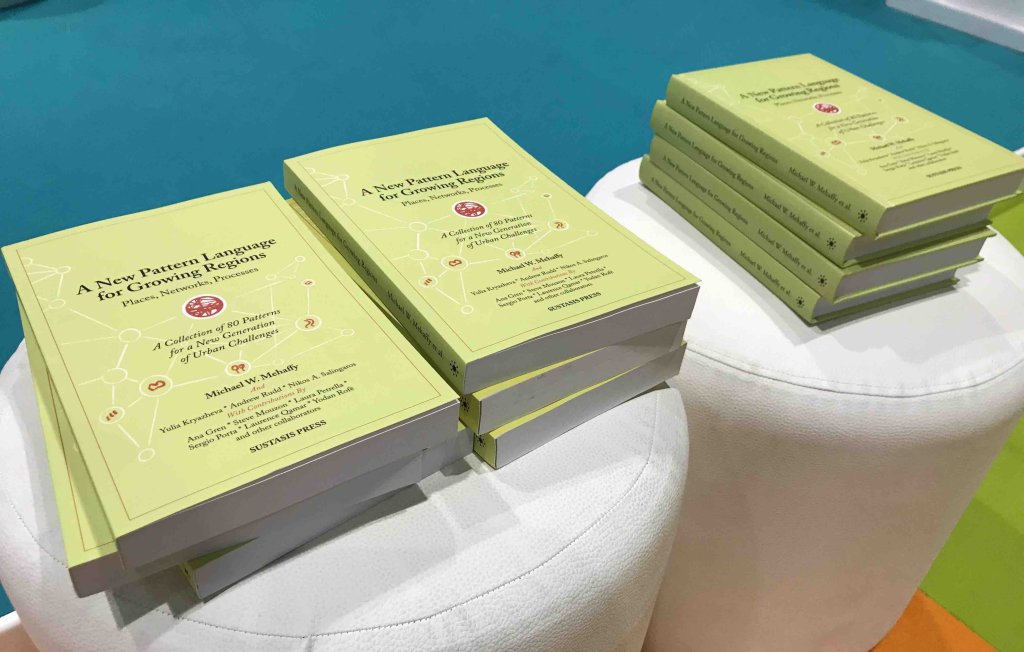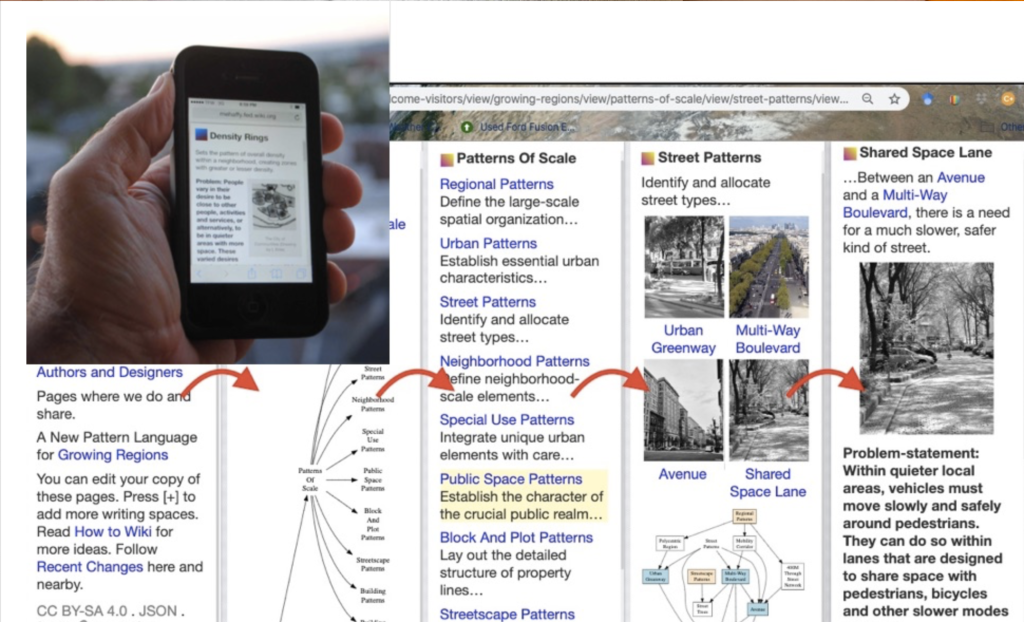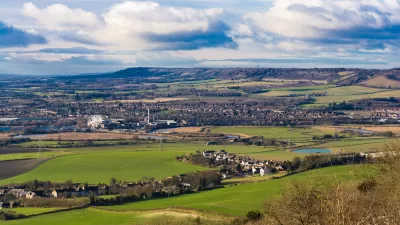Software and other fields have made brilliant progress with the pattern language methodology, while built environment fields lag badly, mired in parochial debates over the massive book that invented the methodology.

Although virtually everyone uses Wikipedia routinely today, it's remarkable how few know its surprising provenance in the world of planning and architecture.
Wiki, the methodology that powers Wikipedia, was invented by a computer scientist named Ward Cunningham to create a web-based system of the "pattern languages of programming"—an idea exported from architect Christopher Alexander's 1977 classic A Pattern Language: Towns, Buildings, Construction.
Pattern languages are, at heart, nothing more than "a method of describing good design practices or patterns of useful organization within a field of expertise," as described by Wikipedia. The "pattern" encapsulates key relationships within the set of design elements, which, if configured in the "right" way, will produce the desired outcome. Each pattern typically includes a name, problem-statement, discussion conclusion, and hyperlinks.
The genius of the method is that each pattern is nested within many other patterns, connected by hyperlinks, to form a relational web-network. The patterns can then be applied in a contextual, language-like way. Software designers clearly found the method enormously productive: pattern languages of programming (or "design patterns") have been put to use in game software, operating systems, and many other programs.
Ward Cunningham, the wiki inventor, actually envisioned each wiki page as a kind of pattern in its own right, with title, photo, summary, discussion, and hyperlinks. A few years after his 1990s invention, the developers of an early online encyclopedia enthusiastically applied the new system (and its name) to their embryonic creation, with now-familiar results. Nor is wiki limited to Wikipedia, of course. It permeates the web (Google Sites, Wikihow, Mediawiki, etc).
Pattern languages have had other phenomenal applications too, growing out of software (leading directly to Agile, Extreme Programming, and Scrum) and also an astonishing range of other fields, from molecular biology to sociology to engineering to manufacturing to seemingly countless others. One can find online citations to papers on pattern languages for music composition, pattern languages for weddings, and even pattern languages for writing patterns(!).
The one field that has lagged most conspicuously is, curiously, the very one for which pattern languages were invented: the built environment. What can explain this anomaly? It seems there are a number of likely factors—the bias of architects against anything that they imagine might limit their "creative freedom" (a debatable idea at best), the greater willingness of other fields, especially technology, to embrace functional innovation (not just novelty for its own sake), and the more pragmatic, less ideologically constrained nature of other disciplines in relation to architecture.
But perhaps the most powerful explanation is the very success of the 1977 book. Resembling nothing so much as bible, A Pattern Language is full of pronouncements that were forever locked in print, and never allowed to be tested and refined. The cult-like veneration shown by some was matched only by the contempt held by others.
Yet this outcome was contrary to the explicit aims of the authors, as they made clear in the introduction:
You see then that the patterns are very much alive and evolving. In fact, if you like, each pattern may be looked upon as a hypothesis like one of the hypotheses of science. In this sense, each pattern represents our current best guess as to what arrangement of the physical environment will work... But of course, no matter what the asterisks say, the patterns are still hypotheses, all 253 of them — and are therefore all tentative, all free to evolve under the impact of new experience and observation. (Alexander et al., 1977, pages xv-xvii)
But that evolution never happened. Instead, the 253 patterns became trapped in their original bible-like volume, protected even by copyright, and never to be altered, added to, or differentiated. Other fields, unencumbered by such a dominant first corpus, made brilliant progress, while work in the built environment stagnated.
So what can be done now to push forward more productive work in the built environment? Two developments offer an opportunity for a fresh start. One of them is the development of a new framework agreement on urbanization, adopted by acclamation by all 193 countries of the United Nations, and known as the New Urban Agenda. Many of the elements of the New Urban Agenda can be expressed in pattern-like forms, offering the potential for a new collection of patterns based on this document.
The other development is a new generation of wiki, authored by the original inventor (and our collaborator), Ward Cunningham. This "federated" wiki allows copies to be made, shared and altered more easily, using handheld or desktop devices. Its capabilities are as broad as the almost endless number of of apps that can be added as modules—data calculations and modeling, field measurements, augmented reality visualization, and a host of other new features undreamt of by the original pattern language authors.
Accordingly, our team, based at the Centre for the Future of Places at KTH University in Stockholm and at Sustasis Foundation in Portland, Oregon, have partnered with Ward Cunningham and other collaborators to develop a new pattern language collection, together with a companion wiki. A New Pattern Language for Growing Regions contains 80 new patterns, many encapsulating elements of the New Urban Agenda. The companion wiki, at npl.wiki, contains the same patterns in wiki form. The wiki is currently read-only, but will become editable and shareable in the near future.

The new patterns reflect not only the New Urban Agenda, but the new thinking about urbanization and its requirements for a more sustainable age—reformist ideas going back to the work of Jane Jacobs and others. They include patterns on mixed use, walkability, public space, multimodal transportation, interconnected street grids, and other characteristics of diverse, well-connected urbanism. There are also patterns covering historic regeneration, slum upgrading, suburban retrofit, and other timely issues. Other patterns cover new technologies, like citizen data and autonomous vehicles. Another category covers implementation tools, including financial mechanisms, governance structures and the like. A more experimental category covers geometric characteristics—similar to those later explored by Alexander—including local symmetries, fractal patterns, grouping and framing.
As with the first generation of patterns, this new collections sets out normative propositions supported by evidence, and accordingly, each pattern has one or more research citations justifying its claims. These can all be debated; the aim is not to end discussion, but to begin it. If another party has an alternative pattern, justified by alternative evidence, let them present it, and let us have a proper debate on the evidence. Let us not continue to argue ex cathedra for sectarian dogma. That is not how the other fields have made such progress in meeting their challenges.

Another point is the normative nature of the patterns. These are unabashedly so, in the belief that all work in the built environment is shaped by normative judgments, and the only question is whether these values are on the table for examination and challenge. As Kevin Lynch pointed out in Good City Form, the danger is not having values, but failing to make them transparent. Too often these values are cloaked behind claims of expertise or artistic privilege, rather than sound examination and collective evaluation.
Some will note that we adhered closely to the original design of the patterns as printed in the book. This is because the original patterns have been proven user-friendly and successful, and attempts at altered versions in the built environment have proven less so. Furthermore, a similar format also helps to make the original patterns more useful as part of larger project-based collections. Alexander and his colleagues also described "the essential purposes behind this format," which suggest that alterations without cause are unwise. This project is intended to be rooted in evidence of what works, and the evidence that the original pattern structure has worked is undeniable.
Finally, this project is meant not as an end but a beginning. The first collection of 80 patterns is only a small and partially representative sampling of what is possible, and surely necessary, as we confront a new generation of challenges. The wiki should make it possible to produce many hundreds or thousands more, just as Wikipedia grew from a few hundred entries to today's vast collection. The patterns can be collected periodically into print editions, or continue in online form, or both. More importantly, they can be applied to specific projects and specific contexts in different parts of the world, adapted, refined and supplemented, so that the most universal patterns can be widely shared, and the entire collection can grow and diversify.
Whether or not this particular project is the spark of a revival of pattern languages in the built environment, we are convinced that such a revival is long overdue. A profound transformation is under way in our technological systems, reflected by Agile Methodology, Scrum, wiki, and yes, patterns. The transformation is driven by a recognition that the old linear methods have failed, and we need better web-networked ways of working, built on better evidence. The current coronavirus pandemic throws these issues into sharp relief, surely. In the built environment especially, the need for ways to document and share successful evidence-based design methodologies, capable of achieving desired goals, is matched only by the current gap in achieving them.
Michael Mehaffy is the executive director of Sustasis Foundation and International Making Cities Livable as well as a senior researcher at the Centre for the Future of Places, KTH University, Stockholm. He was a student and long-time collaborator of Christopher Alexander, and he has been a collaborator of Ward Cunningham for over a decade. More information is available about the wiki and book at the Sustasis Foundation.

Alabama: Trump Terminates Settlements for Black Communities Harmed By Raw Sewage
Trump deemed the landmark civil rights agreement “illegal DEI and environmental justice policy.”

Planetizen Federal Action Tracker
A weekly monitor of how Trump’s orders and actions are impacting planners and planning in America.

The 120 Year Old Tiny Home Villages That Sheltered San Francisco’s Earthquake Refugees
More than a century ago, San Francisco mobilized to house thousands of residents displaced by the 1906 earthquake. Could their strategy offer a model for the present?

LA’s Tree Emergency Goes Beyond Vandalism
After a vandal destroyed dozens of downtown LA trees, Mayor Karen Bass vowed to replace them. Days later, she slashed the city’s tree budget.

Sacramento Leads Nation With Bus-Mounted Bike Lane Enforcement Cameras
The city is the first to use its bus-mounted traffic enforcement system to cite drivers who park or drive in bike lanes.

Seattle Voters Approve Social Housing Referendum
Voters approved a corporate tax to fund the city’s housing authority despite an opposition campaign funded by Amazon and Microsoft.
Urban Design for Planners 1: Software Tools
This six-course series explores essential urban design concepts using open source software and equips planners with the tools they need to participate fully in the urban design process.
Planning for Universal Design
Learn the tools for implementing Universal Design in planning regulations.
Ada County Highway District
Clanton & Associates, Inc.
Jessamine County Fiscal Court
Institute for Housing and Urban Development Studies (IHS)
City of Grandview
Harvard GSD Executive Education
Toledo-Lucas County Plan Commissions
Salt Lake City
NYU Wagner Graduate School of Public Service





























